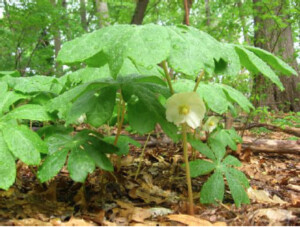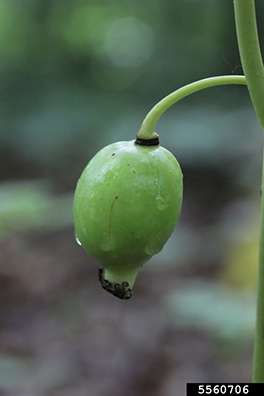
NATIVES TO KNOW
Mayapple, Podophyllum peltatum
Compiled by WORC Secretary Joyce Tuharsky
 It’s no coincidence that many of our native woodland plants flower in early Spring. They are taking advantage of the sunshine that hits the forest floor before the trees fully leaf out. Many of these plants have flowers that point downwards, beneath their foliage, to tempt early insects emerging close to the ground. To see these flowers, you often have to get down to ground level.
It’s no coincidence that many of our native woodland plants flower in early Spring. They are taking advantage of the sunshine that hits the forest floor before the trees fully leaf out. Many of these plants have flowers that point downwards, beneath their foliage, to tempt early insects emerging close to the ground. To see these flowers, you often have to get down to ground level.
One such early plant is the Mayapple (Podophyllum peltatum). Perhaps the showiest aspect of this perennial is its large, twin, umbrella-like leaves on a solitary stem. The leaves remain closed as the stem lengthens, unfolding 6–8 inches across when the plant has reached a height of 1–2 feet. Each leaf is rubbery yet smooth, deeply lobed, and composed of 5–7 wedge-shaped divisions.
In May or June, one pure white drooping flower will emerge between the axil of the 2 leaves. These flowers are about 2 inches wide and shaped like a cup, with 6–9 waxy white petals and many stamens.
 Pollinated flowers will produce large yellow fruits in fall (green, unripe fruit pictured at left). The fruit is lemon-shaped, fleshy, contains many seeds…and is a favorite food of box turtles! The ripe fruit (lemon-like flavor) is also edible in limited amounts by humans and has been used to make preserves and marmalade. However, CAUTION: all other parts of the Mayapple (leaves, roots, and unripe fruit) are poisonous.
Pollinated flowers will produce large yellow fruits in fall (green, unripe fruit pictured at left). The fruit is lemon-shaped, fleshy, contains many seeds…and is a favorite food of box turtles! The ripe fruit (lemon-like flavor) is also edible in limited amounts by humans and has been used to make preserves and marmalade. However, CAUTION: all other parts of the Mayapple (leaves, roots, and unripe fruit) are poisonous.
The root of the Mayapple is composed of many thick tubers, fastened by fleshy fibers, which spread greatly underground. Over time, the plant can spread to form large colonies.
Interestingly, Mayapple flowers require cross-pollination with another Mayapple to set fruit (they are self-sterile). But since the plant often grows in clonal colonies, a given flower may not produce fruit if a Mayapple of a different genetic line is not nearby.
Mayapple contains podophyllotoxin which is used to synthesize drugs for treating certain cancers and leukemias. Currently, the commercial source of podophyllotoxin is from an endangered species of the Himalayas. Recent studies have concluded that the leaf blades of the North American Mayapple could serve as an alternative source of podophyllotoxin.
Mayapples are excellent for naturalizing in moist woodland settings or native plant gardens with partial sun. However, like many other early spring “ephemerals,” the plants slowly wither as they go dormant later in summer. Therefore, Mayflowers are not considered a good border plant.
For more information and photos:
plants.usda.gov
illinoiswildflowers.info/woodland/plants/mayapple
nyctophilia.net/plants/mayapple
